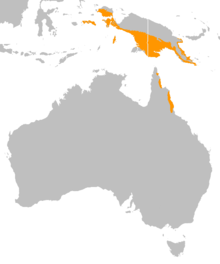Southern cassowaries
| Southern cassowary | |
|---|---|
 |
|
| At the Rainforest Habitat Wildlife Sanctuary, Port Douglas, Australia | |
| Scientific classification | |
| Kingdom: | Animalia |
| Phylum: | Chordata |
| Class: | Aves |
| Order: | Casuariiformes |
| Family: | Casuariidae |
| Genus: | Casuarius |
| Species: | C. casuarius |
| Binomial name | |
|
Casuarius casuarius (Linnaeus, 1758) Brisson 1760 |
|
 |
|
| Distribution of the southern cassowary | |
| Synonyms | |
|
|
The southern cassowary (Casuarius casuarius) also known as double-wattled cassowary, Australian cassowary or two-wattled cassowary, is a large flightless black bird. It is a ratite and therefore related to emu, ostrich, and the Rhea and Kiwi genera. (See also dwarf cassowary and northern cassowary.)
Presently, most authorities consider the southern cassowary monotypic, but several subspecies have been described. It has proven very difficult to confirm the validity of these due to individual variations, age-related variations, the relatively few available specimens (and the bright skin of the head and neck – the basis upon which several subspecies have been described – fades in specimens), and that locals are known to have traded live cassowaries for hundreds, if not thousands of years, some of which are likely to have escaped/been deliberately introduced to regions away from their origin.
Cassowaries are closely related to the kiwis, both families diverging from a common ancestor approximately 40 million years ago.
The binomial name Casuarius casuarius is derived from its Malay name kesuari. The southern cassowary was first described by Carl Linnaeus in his 18th century work, Systema Naturae, as Struthio casuarius, from a specimen from Seram, in 1758. It is now the type species of the genus Casuarius.
The southern cassowary has been described under a large number of scientific names, all of which are now considered taxonomic synonyms for the species.
...
Wikipedia

